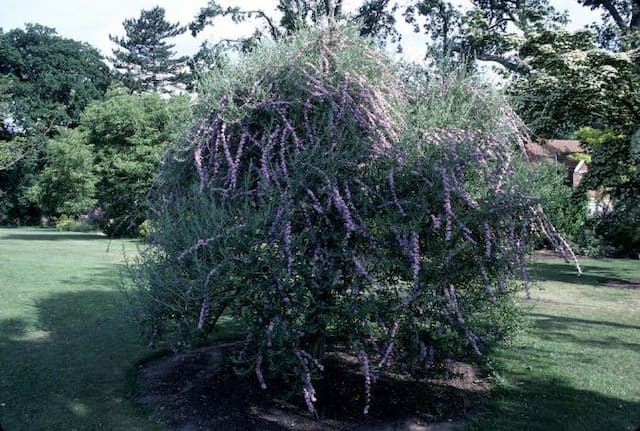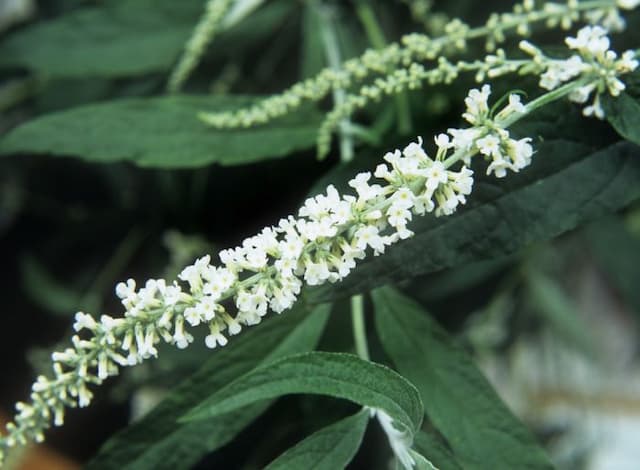Wisley Vanilla Nemesia Nemesia 'Wisley Vanilla'

ABOUT
Nemesia 'Wisley Vanilla' is an ornamental plant known for its delightful and aromatic flowers. Its blossoms are characterized by a creamy white color that may hint towards a soft vanilla shade, reminiscent of the popular spice and ice cream flavor. The blooms typically exhibit a delicate, five-petaled form with each petal softly overlapping its neighbor, creating a harmonious and orderly floral display. The flower's central area often features subtle shades of yellow or light orange, adding a gentle contrast to the creamy petals. This may take the form of delicate streaks or a softly defined throat within the bloom. The flowers of Nemesia 'Wisley Vanilla' are arranged in clusters, creating an eye-catching display that looks abundant and lush. The foliage of Nemesia 'Wisley Vanilla' is also attractive, and forms a pleasing backdrop to the beautiful flowers. The leaves are usually a bright, fresh green, which can appear glossy in the right light. The plant's overall texture is fine and slightly airy due to the slender stems and petite leaves, lending an elegant and soft appearance to the plant. This texture also provides a delicate, feathery contrast to the denser, more compact look of the blooms. The combination of sweetly scented flowers and light, bright green foliage makes Nemesia 'Wisley Vanilla' a highly desirable plant for gardeners looking to add both visual and olfactory appeal to their gardens.
About this plant
 Names
NamesFamily
Plantaginaceae
Synonyms
Wisley Vanilla Nemesia, Cape Jewels
Common names
Nemesia 'Wisley Vanilla'
 Toxicity
ToxicityTo humans
Nemesia 'Wisley Vanilla' is not commonly listed as a toxic plant to humans. However, as with many ornamental plants, it is not intended for ingestion. While few reports of human poisoning exist, consuming any ornamental plant could potentially cause mild stomach upset or an allergic reaction in some individuals. If any part of the plant is ingested, monitor for symptoms and consult a medical professional if any adverse reactions occur.
To pets
Nemesia 'Wisley Vanilla' is not commonly known to be toxic to pets either. However, as with most ornamental plants, it is not intended for consumption by animals. If a pet ingests part of this plant, they may possibly experience mild gastrointestinal upset such as vomiting or diarrhea. If you suspect your pet has ingested this plant and is showing symptoms, it is best to contact your veterinarian.
 Characteristics
CharacteristicsLife cycle
Annuals
Foliage type
Deciduous
Color of leaves
Green
Flower color
White
Height
1 foot (30 cm)
Spread
1 foot (30 cm)
Plant type
Herb
Hardiness zones
9
Native area
South Africa
Benefits
 General Benefits
General Benefits- Attractive Flowers: Nemesia 'Wisley Vanilla' has beautiful, delicate flowers that add aesthetic value to gardens and landscapes.
- Pleasant Fragrance: The plant is known for its sweet vanilla scent, which can enhance the sensory pleasure of a garden.
- Easy to Grow: It is generally easy to cultivate in well-drained soil, making it suitable for gardeners of all skill levels.
- Compact Size: Its small size makes it perfect for borders, pots, and small garden spaces.
- Attracts Pollinators: The flowers attract bees and butterflies, promoting pollination in the garden.
- Long Flowering Season: It has a long blooming period, providing color and interest from spring to fall.
- Versatility: The plant can be used in mixed containers, beds, and as edging plants.
- Low Maintenance: Requires minimal care once established, sparing gardeners from extensive gardening chores.
- Drought Tolerance: Once established, it can tolerate periods of drought, reducing the need for frequent watering.
- Variety of Uses: Can be used for cut flowers, enhancing indoor decoration with its beauty and fragrance.
 Medical Properties
Medical PropertiesThis plant is not used for medical purposes.
 Air-purifying Qualities
Air-purifying QualitiesThis plant is not specifically known for air purifying qualities.
 Other Uses
Other Uses- Art and Craft Inspiration: The delicate flowers of Nemesia 'Wisley Vanilla' can inspire patterns and designs for textiles, embroidery, or porcelain painting, capturing their intricate detail and soft color palette.
- Photography: The plant's aesthetic appeal with its creamy vanilla-colored blooms makes it a captivating subject for garden photography and macro imagery, highlighting nature's beauty.
- Garden Themed Parties: Nemesia can be used as a motif for garden parties or events, with its imagery adorning invitations, table settings, and decorations to create a cohesive floral theme.
- Educational Tool: Gardeners and educators can use Nemesia 'Wisley Vanilla' to teach about plant life cycles, pollination, and the importance of biodiversity in garden ecosystems.
- Culinary Garnish: Although not typically known for culinary use, the flowers could potentially be used as an ornamental garnish for desserts and drinks after ensuring they are safe and pesticide-free.
- Nature Crafts: The flowers and foliage can be incorporated into natural craft projects, like making bookmarks, pressed flower arrangements, or potpourri.
- Perfume Inspiration: The delicate scent of Nemesia 'Wisley Vanilla' may inspire the creation of floral perfumes or scented oils, aiming to capture its unique fragrance note.
- Floral Language and Symbolism: In the language of flowers, Nemesia can be used to symbolize concepts like friendship or fascination, making it a thoughtful addition to a bouquet with particular meaning.
- Ice Cubes: For an unusual table presentation, freeze small Nemesia flowers into ice cubes to float in a punch bowl or to add a decorative touch to individual drinks.
- Seed Saving and Exchange: Gardeners can collect seeds from Nemesia 'Wisley Vanilla' to participate in seed exchange programs, sharing the beauty of the plant with others and promoting genetic diversity.
Interesting Facts
 Feng Shui
Feng ShuiThe Nemesia is not used in Feng Shui practice.
 Zodiac Sign Compitability
Zodiac Sign CompitabilityThe Nemesia is not used in astrology practice.
 Plant Symbolism
Plant Symbolism- Sweetness: The plant's common name 'Wisley Vanilla' suggests a sweet fragrance, often symbolizing pleasant experiences and kindness.
- Comfort: Its vanilla-like scent might evoke a sense of comfort and nostalgia, much like the soothing effect of vanilla itself.
- Delight: The cheerful colors of the Nemesia flowers can symbolize joy and the simple delights of life.
- Friendship: The bright and inviting appearance of the flowers might represent strong bonds of friendship and camaraderie.
- Charm: The delicate and charming aesthetic of the blooms can symbolize enchantment and allure in various cultural contexts.
 Water
WaterNemesia 'Wisley Vanilla', also known as Cape Jewels, should be watered regularly to maintain moist soil, especially during dry periods. It's essential to avoid waterlogging, so ensure that the soil drains well. A good rule of thumb is to provide Cape Jewels with approximately 1 inch of water per week, which is about 0.6 gallons for an average-sized plant. During the hot summer months, you may need to water more frequently, while in cooler months, less frequent watering is required. Always check the top inch of soil before watering; if it feels dry to the touch, it's time to water.
 Light
LightNemesia 'Wisley Vanilla' or Cape Jewels thrives best in full to partial sunlight. Ideally, the plant should be placed in a spot where it receives at least 6 to 8 hours of sunlight per day. Morning sun with some afternoon shade is optimal to protect the flowers from the intense heat of the day. Good light is crucial for the best flowering, but too much direct sun in very hot climates can be detrimental.
 Temperature
TemperatureCape Jewels prefer a temperature range between 50°F and 72°F for optimal growth. They can tolerate a minimum temperature of about 30°F, but frost can damage or kill the plants. The ideal temperature for Nemesia 'Wisley Vanilla' is a mild daytime temperature that doesn't exceed the low 70s°F. Consistent temperatures outside of this range can negatively affect the plant's health and blooming cycle.
 Pruning
PruningPruning Nemesia 'Wisley Vanilla' or Cape Jewels encourages bushier growth and more blooms. Lightly trim or pinch back the tips of the growth regularly to stimulate branching. It's best to prune in the early spring or after a flush of blooming to rejuvenate and shape the plant, which can be done every few weeks during the growing season. Remove any spent flowers or dead growth to maintain a tidy appearance and promote further blooming.
 Cleaning
CleaningAs needed
 Soil
SoilNemesia 'Wisley Vanilla' thrives best in a well-draining, loamy soil mix with a pH range of 5.5 to 7. Amend the soil with organic matter and a slow-release fertilizer to support healthy growth and flowering.
 Repotting
RepottingNemesia 'Wisley Vanilla' typically needs repotting every year to refresh the soil and to accommodate root growth. It's best done in the spring before the onset of the growing season.
 Humidity & Misting
Humidity & MistingNemesia 'Wisley Vanilla' prefers moderate humidity levels, but as a hardy plant, it is quite adaptable and does not require any special humidity considerations when grown outdoors.
 Suitable locations
Suitable locationsIndoor
Place near a sunny window and keep the soil moist.
Outdoor
Plant in full sun to part shade and well-draining soil.
Hardiness zone
9-11 USDA
 Life cycle
Life cycleNemesia 'Wisley Vanilla', commonly known as Wisley Vanilla Nemesia, begins its cycle as a seed, which when sown, germinates within a week or two, given warmth and moisture. Once germinated, the seedlings grow and develop into young plants, which need to be thinned and can be transplanted to their flowering sites. The vegetative growth stage follows, with plants producing lush foliage before their flowering stage, where they bloom profusely with creamy white, vanilla-scented flowers from late spring through summer. After pollination, flowers will develop into seed pods if not deadheaded. In the autumn, as temperatures cool, the plant will begin to die back, entering a dormant period or completing its life cycle if it is treated as an annual. If the conditions are favorable, some Nemesia 'Wisley Vanilla' may act as perennials, regrowing from the same roots the following spring.
 Propogation
PropogationPropogation time
Spring-Early Summer
The Nemesia 'Wisley Vanilla', commonly known as Nemesia, is best propagated through seed. This plant blooms in late spring to summer, therefore the optimal time for sowing seeds is in late winter to early spring, indoors, roughly 6 to 8 weeks before the last frost is expected. To propagate Nemesia from seed, fill a tray with a well-draining seed starting mix, dampen the soil, and sprinkle the tiny seeds on top. It's important not to cover the seeds with soil since they require light to germinate. Place the tray in a warm location with plenty of indirect sunlight and keep the soil moist but not waterlogged. Germination typically occurs within 10 to 20 days. Once the seedlings are large enough to handle and all danger of frost has passed, they can be transplanted outdoors into a sunny spot with well-drained soil.



![Butterfly bush [Florence]](/_next/image?url=https%3A%2F%2Fplants-admin.emdemapps.com%2Fimages%2Fplants%2F%2Fimages%2F604b5f52d7bb1.png&w=640&q=75)
![Butterfly bush [Marbled White]](/_next/image?url=https%3A%2F%2Fplants-admin.emdemapps.com%2Fimages%2Fplants%2F%2Fimages%2F604b63353832a.png&w=640&q=75)
![Butterfly bush [Nanho Blue]](/_next/image?url=https%3A%2F%2Fplants-admin.emdemapps.com%2Fimages%2Fplants%2F%2Fimages%2F604b55d0a6d2d.png&w=640&q=75)



![Aloha [Honey Dark Yellow]](/_next/image?url=https%3A%2F%2Fplants-admin.emdemapps.com%2Fimages%2Fplants%2F%2Fimages%2F604b53868dde8.png&w=640&q=75)